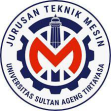The Effect of Temperature in Cryogenic Treatment on the Mechanical Properties and Microstructure of High-Speed Steel SKH 51
Abstract
High-speed steel SKH 51 has excellent mechanical properties, including high hardness and wear resistance. This material is widely used for cutting tools and drills. Service life is also a crucial factor that is often improved to extend the material’s usability. To enhance the service life of SKH 51, a heat treatment modification was applied, specifically cryogenic treatment, to increase its hardness and wear resistance. The process began with austenitization, followed by quenching using N₂ gas. Subsequently, cryogenic treatment was conducted at varying temperatures of -80°C, -110°C, and -140°C, with a holding time of 30 minutes. Finally, a tempering process was done at 540°C with a holding time of 3 hours. The microstructure and mechanical properties after the applied heat treatment were studied. In the as-received condition, the microstructure consisted of pearlite, ferrite, and coarse carbides. After the heat treatment, martensite and carbides formed in significant amounts, with only a small fraction of retained austenite remaining after the cooling process. X-ray diffraction (XRD) analysis revealed carbide phase peaks such as MC, M₂C, and M₆C. The hardness value increased as the cryogenic treatment temperature decreased over the 30-minute duration. Wear resistance was measured using the Oghoshi wear test method, showing an improvement as the cryogenic treatment temperature decreased. The increase in hardness and wear resistance of SKH 51 was attributed to the greater formation of martensite and carbides, which reduced the amount of retained austenite..
Keywords
Full Text:
PDFReferences
Lakhani MM, Raut N. A review on effect of cryogenic treatment on different grades of steel. Int J Sci Eng Res. 2017;6(5): p. 8070-8080.
Worasaen K, Suwanpinij P, Tuchinda K. Effect of cryogenic treatment on the microstructure modification of SKH51 steel. Applied Science and Engineering Progress. 2022; 16(1): p. 5588-5588.
Homjabok W, Keawdonree S, Duadsanthia S, Thammachot N, Praditja T, Taweejun N. Effect of gas nitrocarburizing process on hardening of high speed tool steel grade SKH51. วารสาร วิชาการ พระจอมเกล้า พระนครเหนือ. 2022;32(1): p. 77-86.
Chai Z, Lu Q, Hu J, Wang L, Wang Z, Wang J, Xu W. Effect of retained austenite on the fracture behavior of a novel press-hardened steel. Journal of Materials Science & Technology. 2023;135: p. 34-45.
Singh G, Pandey K. Effect of cryogenic treatment on properties of materials: A review. Proceedings of the Institution of Mechanical Engineers, Part E: Journal of Process Mechanical Engineering. 2022;236(4): p. 1758-1773.
Varghese V, Ramesh M, Chakradhar D. Influence of deep cryogenic treatment on performance of cemented carbide (WC-Co) inserts during dry end milling of maraging steel. Journal of Manufacturing Processes. 2019; 37: p. 242-250.
Wu C, Chen W, Chen L Effects of cryogenic treatment on mechanical property and microstructure of JIS SKH51 high-speed steel. in IOP Conference Series: Materials Science and Engineering. 2015;IOP Publishing.
Che B, Lu L, Zhang J, Zhang J, Ma M, Wang L, Qi F. Effects of cryogenic treatment on microstructure and mechanical properties of AZ31 magnesium alloy rolled at different paths. Materials Science and Engineering: A. 2022;832: p. 142475.
Gill S, Sing J, Sing R, Sing H. Effect of cryogenic treatment on AISI M2 high speed steel: metallurgical and mechanical characterization. Journal of Materials Engineering and Performance. 2012;21: p. 1320-1326.
Kumar KS, Maneiah D. Design and Thermal Analysis of SUbzero Process. Anveshana's International Journal of Researchin Engineering and Applied Science. 2017.
Niessen FM, Villa, Somers MA. Martensite formation from reverted austenite at sub-zero Celsius temperature. Metallurgical and Materials Transactions A. 2018; 49: p. 5241-5245.
Senthilkumar D. Cryogenic treatment: Shallow and deep. Encyclopedia of Iron, Steel, and Their Alloys; Totten, GE, Colas, R., Eds. 2016; p. 995-1007.
Jovičević-Klug P, Jenko M, Jovičević-Klug M, Batič BS, Kovač J, Podgornik B. Effect of deep cryogenic treatment on surface chemistry and microstructure of selected high-speed steels. Applied Surface Science. 2021; 548: p. 149257.
Klug PJ. Mechanisms And Effect Of Deep Cryogenic Treatment On Steel Properties. Doctoral Dissertation Jozef Steffan International Postgraduate School. 2022: Slovenia
Hutchings I, Shipway P. Tribology: friction and wear of engineering materials. 2017; Butterworth-heinemann.
Chan KS. Study of Fatigue Behaviour Of High Speed Steel Skh51 In Forging Process. 2020;UTAR.
Himabindu B, Devi NL, Kanth BR. Microstructural parameters from X-ray peak profile analysis by Williamson-Hall models; A review. Materials Today: Proceedings. 2021;47: p. 4891-4896.
Jirandehi AP, Khonsari M. On the determination of cyclic plastic strain energy with the provision for microplasticity. International Journal of Fatigue. 2021; 142: p. 105966.
Gas L. Sub-zero Treatment of Steels. Technology/Processes/Equipment, heattreatmentlinde. com, 2010.
Liu D, Liu D, Zhang X, Liu C, Ao N. Surface nanocrystallization of 17-4 precipitation-hardening stainless steel subjected to ultrasonic surface rolling process. Materials Science and Engineering: A. 2018;726: p. 69-81.
DOI: http://dx.doi.org/10.62870/fwl.v11i1.31173
Refbacks
- » —







